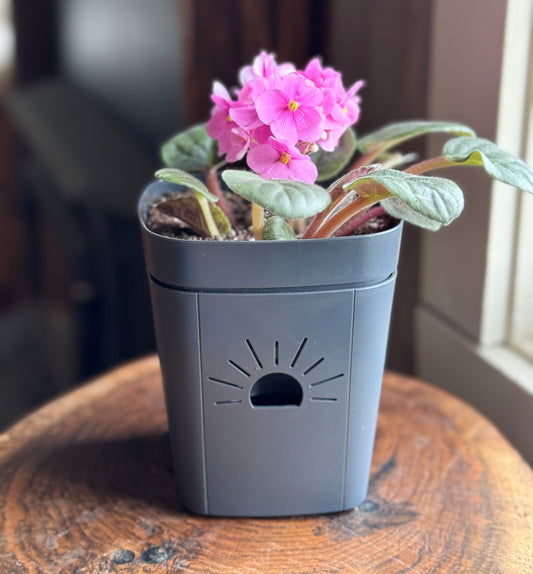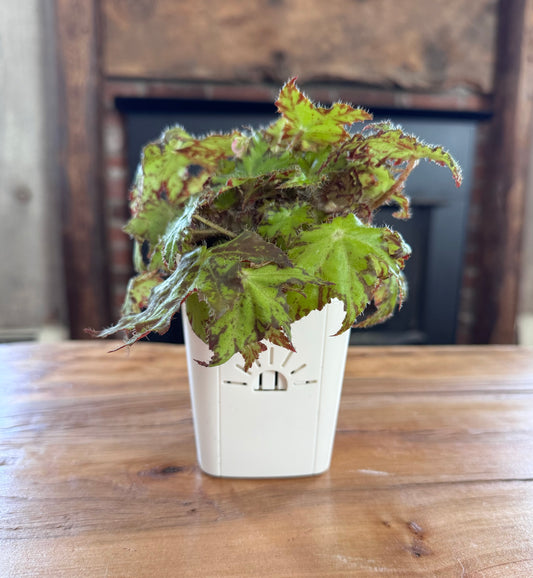Origins
Members of the Syngonium genus, which is part of the Araceae family, are native to tropical rainforests in Central and South America, Mexico, and the West Indies. These woody vines can grow up to 30-60 feet or more if planted in trees. As the plant matures, its leaves become more lobed than their juvenile versions, which are commonly seen as houseplants. The most popular species for domestic cultivation is Syngonium podophyllum, simply referred to as Syngonium.
Syngonium plants can be found in various locations, such as tropical rainforests, subtropical forests, thickets, and wetlands. They are mostly native to tropical America, with the highest concentration of the genus being in Costa Rica and Panama. The second highest concentration can be found in Mexico. The most common species is S. podophyllum, which has spread from Mexico to Brazil. It is thought that the Mexican and Costa Rican populations of Syngonium have been isolated for some time, resulting in distinct morphological differences.
Light
Requirements
Syngonium plants can tolerate low light levels, but they will grow faster and keep their vibrant colors if grown in medium to bright indirect light for at least 6 hours a day. Direct sunlight should be avoided as it may scorch the leaves. If your space is light-challenged, LED grow lights are a great option. Also, it is important to rotate the plant ¼ turn each time you water it, which will help it grow evenly and balanced.
Genus Summary
| GENUS | Syngonium |
| COMMON NAMES | Arrowhead vine, Arrowhead philodendron. |
| LIGHT | Medium or Bright Indirect Light |
| WATER SCHEDULE | Naked Root = 14 days |
| WATER REQUIREMENTS | Conventional Planter = Allow top 2 inches of soil to dry between waterings. |
| HUMIDITY | Average. Over 40 percent |
| TEMPERATURE | Average. 60-86°F. Never below 50°F. |
| FEEDING | 1x month |
| TOXICITY | Toxic to humans and animals |
| PESTS | Spider mites, mealybugs, aphids. |
| DISEASES | Root and stem rot and leaf spots caused by Erwinia, Pseudomonas, and Xanthomonas. |
| POT | Maximum root zone aeration to mimic natural growing environment and prevent rot |
| SOIL | 55% coco coir or peat moss, 20% perlite, and 25% organic compost |
| FERTILIZER | Diluted to quarter strength every 14 days. |
| PROPAGATION | By stem cuttings rooted in water or soil |
| PRUNING | Prune leggy stems to encourage bushiness. |
| SIZE | 2-6 feet indoors |
Water Requirements
If growing your Syngonium in a Naked Root planter, please follow a 14-day watering schedule.
Give your Syngonium plants a chance to dry out a bit between waterings. Too dry, and the lower leaves may become brown and dry up. If this happens, give the soil a thorough soaking and let the plant rehydrate. The leaves can also turn yellow or brown if the soil is too wet for extended periods. Waterlogged soil creates a situation where oxygen cannot reach the roots and is a breeding ground for bacteria and disease. To prevent this issue, water with less water more frequently, and try this approach if the leaves start to turn yellow or brown suddenly.
Humidity
Humidity levels of 40-50% are suitable for Syngonium houseplants, but it can be beneficial to provide higher humidity if possible. There are various methods of increasing the humidity around your arrowhead vines, so choose the one that fits your needs and lifestyle.
Temperature
For optimal growth, the temperature should remain at 60 to 65°F during winter and should increase to 68 to 86 °F during the growing season. Arrowhead Vines can survive in most household temperatures ranging from 60-80 degrees Fahrenheit but should not go lower than 50℉. To protect them during winter, keep them away from drafts and doorways.
Toxicity
Syngonium plants are toxic if ingested, so be mindful of any pets or young children in the vicinity. The twigs of the plant contain a sharp calcium oxalate crystal, which can cause skin irritation, itching, burning, and blisters if the plant is touched. If the plant’s juice gets into the eyes, it will cause burning and tearing. If it comes in contact with the mouth’s mucous membranes, it will cause a sharp and painful swelling. Ingestion of the plant will result in inflammation of the gastrointestinal mucosa.
Pests and Diseases
To prevent pests, the Syngonium should be kept in a warm, clean environment with plenty of bright but indirect light. Keep the leaves wiped off regularly to reduce potential pest infestations.
If spider mites are suspected, use a flashlight and magnifying glass to check closely on both sides of all the leaves for tiny webs or specks that move slowly. Mealybugs can also be identified by their cottony white appearance on foliage and stems. Aphids are small green insects that cluster around buds and new growth, while scale insects can appear as yellow-orange bumps along stems and leaves. If an infestation does occur, using insecticidal soap or neem oil is an effective way of controlling these pests without harming your plant.
Common diseases are:
- Bacterial Blight and Stem Rot are caused by the Erwina pathogen. This will appear as dark green spots that cover the leaf and rot it, causing a foul odor.
- Bacterial Leaf Spot caused by Erwinia, Pseudomonas, and Xanthomonas. This will cause clear spots on the edges of the leaves.
- Myrothecium Leaf Spot is caused by a lack of fertilization. Plants will be stunted and may show dark brown spotting on leaves in concentric circles.
Pot
Since Syngonium is susceptible to fungi and bacteria caused by overwatering, a pot with aeration at the roots, similar to how it would grow in nature, is ideal. Root aeration has the added benefit of stimulating hundreds of tiny root hairs that will take up water and nutrients quickly and efficiently, making the plant vigorous and healthy.
Soil
For all Syngonium plants, nutrient-rich potting soil with good drainage is ideal. Coco coir or peat-based potting soil mixes are usually sufficient, but avoid soil with water-retentive crystals as they can cause root rot. If desired, mix together 55% coco coir or peat moss, 20% perlite, and 25% organic compost (like worm castings) for an optimal growing medium.
Fertilizer
When it comes to fertilizing your arrowhead vine, you should aim to do so twice a month during the growing season using quarter-strength complete liquid fertilizer. This will help the plant develop large leaves and a strong root system which is important for healthy growth.
Alternatively, you can also use slow-release fertilizer or top dress with worm castings or compost in early spring. However, it is not recommended that you apply any fertilizer at all during the winter season, as this could be detrimental to your plant’s health.
Propagation
Propagating Syngoniums from cuttings is easy! Select a healthy stem with at least one leaf. Cut the stem just below the node and place it either in water or moist compost. If using water, make sure that the node of the cutting is submerged so that new roots can grow without any issues. In two weeks, you should be able to see small white roots growing. Once they reach an inch long, transplant your new plant into a pot filled with soil and keep it properly hydrated.
Never let your Syngonium sit in wet soil for too long, as this could cause root rot! Keep in mind that even though these plants are easy to propagate, not all cuttings will take root successfully. Some may die before producing new roots or develop brown spots on their leaves due to a lack of oxygen. Be patient, and if possible, try multiple cuttings at once for better chances of success!
Pruning
Pruning your Syngonium is an important part of caring for the plant. If you prefer a more delicate look, cut off any climbing stems that develop so that the leaves remain arrow-shaped and the plant stays bushy rather than climbing. However, some varieties, like White Butterfly, tend to spread quickly and may need regular pruning in order to maintain their shape.
Don’t be afraid to trim these plants back, as they actually respond well to it! Pruning encourages fuller growth and allows you to control how large or compact your Syngonium remains. For those who don’t want a runaway Arrowhead Vine, choose varieties like Allusion, which tend naturally stay more compact with less pruning required.
10 Striking Varieties and Cultivars
Syngoniums are an effortless plant to tend to, so long as you take the time to water them regularly. They can survive in low-light conditions and will thrive in any part of your home. With a variety of colors and patterns, these plants are ideal for any person looking to add a touch of life to their space. Here are a few of our favorites!
Syngonium ‘Neon Robusta’ – Plant collectors who enjoy adding vibrancy to their indoor gardens should consider obtaining the ‘Neon Robusta’ or Pink Syngonium. This type of Syngonium is renowned for its beautiful foliage, with its young leaves being green and pink along the veins and its underside a striking pink hue. Each leaf seems to shine with a high-gloss finish. Furthermore, it is known to grow quickly and is an ideal climber.
Syngonium ‘Snow White’ – Syngonium ‘Snow White’ is a stunning cultivar of Syngonium that is perfect for those new to owning houseplants. It has compact, arrow-shaped leaves with highly variegated shades of green and white speckles. This variety does not trail as much as other types, lending it an organized and neat look when placed in the home or office. Because this cultivar of Syngonium has low maintenance requirements, it grows well even in small spaces or areas with less light.
Syngonium ‘Gold Allusion’ – Syngonium’ Gold Allusion’ is an eye-catching cultivar of Syngonium that can add a splash of light to any room. Its medium-sized, heart-shaped leaves are painted with irregular patterns in vibrant green and gold shades, highlighted by pink veins. With its trailing habit, this plant looks stunning when hung from the ceiling or placed on shelves for maximum visibility. For best results, it should be kept in shady areas where it will retain its bright colors. However, if exposed to too little sunlight, the golden hue may begin to fade over time.
Syngonium ‘Albo Variegatum’ – Syngonium’ Albo Variegatum’ or Variegated Syngonium is a popular choice among plant collectors due to its attractive and unique foliage. Its arrow-shaped leaves feature a beautiful variegation of both emerald green and bright white, making it truly eye-catching. Not only does this cultivar boast ornamental beauty, but it also grows very vigorously with long vines that can be pruned back if desired for a bushier look. Pruning the vines also provides an opportunity for propagation so you can enjoy more of these gorgeous plants in your home! This plant has a tendency to produce all-green leaves over time. To retain the desired variegation, cut off any vines that have matured into solid green. Cut back to the first leaf that exhibits balanced variegation, and this will encourage new growth with more colorful patterns. With consistent pruning and care, you can keep your Syngonium looking vibrant and healthy!
Syngonium ‘Pink Splash’ – How about a hot pink arrowhead plant? This cultivar features leaves that are rhomboid in shape and both vibrant pink splashed with green and emerald green spotted with pink. The combination is very exotic. Provide bright, indirect lighting. Too low of light and the pink will start to fade.
Syngonium ‘Emerald Gem’ – This arrowhead plant looks like marble in every shade of green. There are striations of white mixed in with the green for a truly tropical feel. The leaves are large and deeply sagittate, looking much like giant marbled hearts. This variety is tolerant of dim lighting.
Syngonium ‘Wendlandii’ – Syngonium ‘Wendlandii’ is a popular houseplant with arrow-shaped leaves that have an interesting velvet texture. This foliage has striking green and silver variegation that looks almost metallic in certain lights. As the plant matures, these lobed leaves form distinct leaflets, which gives it its other name – ‘Silver Goosefoot’ – due to its resemblance to the webbed feet of a goose. This variety of Syngonium is known for being both vigorous and easy to care for, thriving in bright indirect light or semi-shade and requiring moderate watering once the soil has dried out between waterings. It’s also important to provide some kind of support, such as moss poles so that it can climb with its aerial roots. With just a little bit of love and attention, this beautiful houseplant will stay happy for many years!
Syngonium ‘Strawberry Cream’ – As a cultivar of Syngonium, ‘Strawberry Cream’ is an incredibly unique and attractive plant. Its leaves are especially eye-catching, as they are the perfect combination of pink and green. The young leaves will be more strikingly pink than their mature counterparts, which feature hints of pink that create stunning veining across the surface. In terms of growth habits, this particular variety can either trail or grow into an upright bush, depending on how you prune it. If left alone to its own devices, it may take on an intermediate form between the two extremes.
Syngonium ‘Pink Allusion’ – This cultivar features muted green leaves mixed with green for an overall appearance of purplish leaves. Each leaf is deeply lobed and can reach up to 12 inches long. This plant stays in a nice tidy shape and does not grow wildly, like some other Synngoniums, making it a good choice for smaller spaces. It is often confused with Neon Robusta, which also has pink leaves, but of a more muted shade.
Syngonium ‘White Butterfly’ – This cultivar has wide heart-shaped leaves that are white, silver, and cream when young. As the leaves mature, they turn into pale green hearts with white veins. This is a vigorous grower that will happily race to the top of a moss pole. To keep it bushy and tidy, prune it at least once each growing season.
Summary of Syngonium Plant Care
To keep your Syngonium happy, provide it with medium or bright indirect light, allow it to dry out between waterings, and fertilize every two weeks. It is content in average household temperatures and humidity levels. Plant it in nutrient-rich potting soil with good drainage and a pot with excellent root zone aeration. Prune the plant once during the growing season if you prefer a bushier appearance, and keep it out of reach of children and pets as it is a poisonous plant.





 Verified Buyer
Verified Buyer









